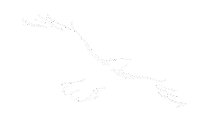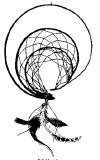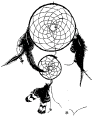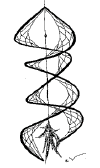The Soul of the Indian
Eastman, Charles Alexander (1911)
III.
CEREMONIAL AND SYMBOLIC WORSHIP
Modern Perversions of Early Religious Rites. The Sun
Dance. The Great Medicine Lodge. Totems and Charms. The Vapor-Bath and the
Ceremonial of the Pipe.
THE public religious rites of the Plains Indians are few,
and in large part of modern origin, belonging properly to the so-called
"transition period." That period must be held to begin with the first
insidious effect upon their manners and customs of contact with the dominant
race, and many of the tribes were so in influenced long before they ceased
to lead the nomadic life.
The fur-traders, the "Black Robe" priests, the military,
and finally the Protestant missionaries, were the men who began the
disintegration of the Indian nations and the overthrow of their religion,
seventy-five to a hundred years before they were forced to enter upon
reservation life. We have no authentic study of them until well along in the
transition period, when whiskey and trade had already debauched their native
ideals.
During the era of reconstruction they modified their
customs and beliefs continually, creating a singular admixture of Christian
with pagan superstitions, and an addition to the old folk-lore of disguised
Bible stories under an Indian aspect. Even their music shows the influence
of the Catholic chants. Most of the material collected by modern observers
is necessarily of this promiscuous character.
It is noteworthy that the first effect of contact with the
whites was an increase of cruelty and barbarity, an intensifying of the dark
shadows in the picture! In this manner the "Sun Dance" of the Plains
Indians, the most important of their public ceremonials, was abused and
perverted until it became a horrible exhibition of barbarism, and was
eventually prohibited by the Government.
In the old days, when a Sioux warrior found himself in the
very jaws of destruction, he might offer a prayer to his father, the Sun, to
prolong his life. If rescued from imminent danger, he must acknowledge the
divine favor by making a Sun Dance, according to the vow embraced in his
prayer, in which he declared that he did not fear torture or death, but
asked life only for the sake of those who loved him. Thus the physical
ordeal was the fulfillment of a vow, and a sort of atonement for what might
otherwise appear to be reprehensible weakness in the face of death. It was
in the nature of confession and thank-offering to the "Great Mystery,"
through the physical parent, the Sun, and did not embrace a prayer for
future favors.
The ceremonies usually took place from six months to a
year after the making of the vow, in order to admit of suitable preparation;
always in midsummer and before a large and imposing gathering. They
naturally included the making of a feast, and the giving away of much savage
wealth in honor of the occasion, although these were no essential part of
the religious rite.
When the day came to procure the pole, it was brought in
by a party of warriors, headed by some man of distinction. The tree selected
was six to eight inches in diameter at the base, and twenty to twenty-five
feet high. It was chosen and felled with some solemnity, including the
ceremony of the "filled pipe," and was carried in the fashion of a litter,
symbolizing the body of the man who made the dance. A solitary teepee was
pitched on a level spot at some distance from the village the pole raised
near at hand with the same ceremony, in the centre a circular enclosure of
fresh-cut.
Meanwhile, one of the most noted of our old men had carved
out of rawhide, or later of wood, two figures, usually those of a man and a
buffalo. Sometimes the figure of a bird, supposed to represent the Thunder,
was substituted for the buffalo. It was customary to paint the man red and
the animal black, and each was suspended from one end of the cross-bar which
was securely tied some two feet from the top of the pole. I have never been
able to determine that this cross had any significance; it was probably
nothing more than a dramatic coincidence that surmounted the Sun-Dance pole
with the symbol of Christianity.
The paint indicated that the man who was about to give
thanks publicly had been potentially dead, but was allowed to live by the
mysterious favor and interference of the Giver of Life. The buffalo hung
opposite the image of his own body in death, because it was the support of
his physical self, and a leading figure in legendary lore. Following the
same line of thought, when he emerged from the solitary lodge of
preparation, and approached the pole to dance, nude save for his
breech-clout and moccasins, his hair loosened daubed with clay, he must drag
after him a buffalo skull, representing the grave from which he had escaped.
The dancer was cut or scarified on the chest, sufficient
to draw blood and cause pain, the natural accompaniments of his figurative
death. He took his position opposite the singers, facing the pole, and
dragging the skull by leather thongs which were merely fastened about his
shoulders. During a later period, incisions were made in the breast or back,
sometimes both, through which wooden skewers were drawn, and secured by
lariats to the pole or to the skulls. Thus he danced without intermission
for a day and a night, or even longer, ever gazing at the sun in the
daytime, and blowing from time to time a sacred whistle made from the bone
of a goose's wing.
In recent times, this rite was exaggerated and distorted
into a mere ghastly display of physical strength and endurance under
torture, almost on a level with the Caucasian institution of the bull-fight,
or the yet more modern prize-ring. Moreover, instead of an atonement or
thank-offering, it became the accompaniment of a prayer for success in war,
or in a raid upon the horses of the enemy. The number of dancers was
increased, and they were made to hang suspended from the pole by their own
flesh, which they must break loose before being released. I well remember
the comments in our own home upon the passing of this simple but impressive
ceremony, and its loss of all meaning and propriety under the demoralizing
additions which were some of the fruits of early contact with the white man.
Perhaps the most remarkable organization ever known among
American Indians, that of the "Grand Medicine Lodge," was apparently an
indirect result of the labors of the early Jesuit missionaries. In it
Caucasian ideas are easily recognizable, and it seems reasonable to suppose
that its founders desired to establish an order that would successfully
resist the encroachments of the "Black Robes." However that may be, it is an
unquestionable fact that the only religious leaders of any note who have
arisen among the native tribes since the advent of the white man, the
"Shawnee Prophet" in 1762, and the half-breed prophet of the "Ghost Dance"
in 1890, both founded their claims or prophecies upon the Gospel story. Thus
in each case an Indian religious revival or craze, though more or less
threatening to the invader, was of distinctively alien origin.
The Medicine Lodge originated among the Algonquin tribe,
and extended gradually throughout its branches, finally affecting the Sioux
of the Mississippi Valley, and forming a strong bulwark against the work of
the pioneer missionaries, who secured, indeed, scarcely any converts until
after the outbreak of 1862, when subjection, starvation, and imprisonment
turned our broken-hearted people to accept Christianity seemed to offer them
the only gleam of kindness or hope.
The order was a secret one, and in some respects not
unlike the Free Masons, being a union or affiliation of a number of lodges,
each with its distinctive songs and medicines. Leadership was in order of
seniority in degrees, which could only be obtained by merit, and women were
admitted to membership upon equal terms, with the possibility of attaining
to the highest honors. No person might become a member unless his moral
standing was excellent, all candidates remained on probation for one or two
years, and murderers and adulterers were expelled. The commandments
promulgated by this order were essentially the same as the Mosaic Ten, so
that it exerted a distinct moral influence, in addition to its ostensible
object, which was instruction in the secrets of legitimate medicine.
In this society the uses of all curative and herbs known
to us were taught exhaustively and practiced mainly by the old, the younger
members being in training to fill the places of those who passed away. My
grandmother was a well-known and successful practitioner, and both my mother
and father were members, but did not practice.
THE GREAT MYSTERY -
2
THE FAMILY ALTAR -
2
CEREMONIAL AND SYMBOLIC WORSHIP
-
2
BARBARISM AND THE MORAL CODE
-
2
UNWRITTEN SCRIPTURES
-
2
ON THE BORDERLAND OF SPIRITS
-
2
White Eagle Soaring: Dream Dancer of the 7th Fire







 Get
a course to promote your business online, explode your sales
Get
a course to promote your business online, explode your sales Get
software to promote your business online in less time
Get
software to promote your business online in less time Get
software to streamline your business and run it hands free.
Get
software to streamline your business and run it hands free.